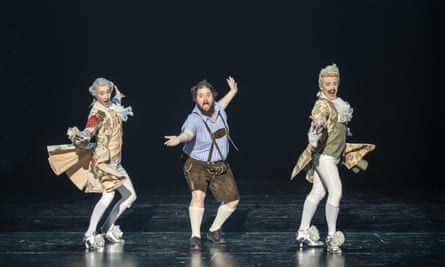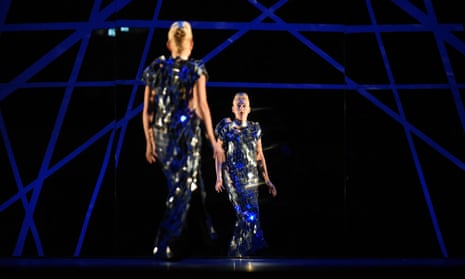In Jean-Philippe Rameau’s Hippolyte et Aricie, an older woman falls for a younger man. He spurns her and loves someone else. Based on Racine and Euripides, it’s a shattering tale. At every opportunity Rameau (1683-1764), that great free-spirit composer of the French Enlightenment, fills his music with weather – tempests, thunderclaps, earthquakes – reflecting the storm of human emotions on stage. For the Berlin State Opera’s (Staatsoper) first ever staging of a Rameau work, conducted by his tireless champion, Simon Rattle, the company chose a designer obsessed with the elements: the Danish-Icelandic artist Olafur Eliasson, whose The Weather Project had a sunburst success back in 2003-4 as one of Tate Modern’s early Turbine Hall commissions.
The opera was the highlight of the Staatsoper’s first baroque festival, which runs until mid-December. A superb revival of Monteverdi’s L’Orfeo and a programme of madrigals in the Pierre Boulez Saal by the peerless Voces Suaves also stood out in the opening weekend. Rameau was the draw. In the grand structure of French opera of this period – five acts with dance and spectacle – the allegorical prologue should be extravagant.
So it was. Shafts of green light pierced the darkness, crisscrossing and filling the auditorium with disco-style flashes and lasers. Illuminated headdresses – Borromean rings worn like luminous cages – created a sense of disembodiment. If you wanted naturalistic drama, you’d come to the wrong place. Cloud mists, an Eliasson hallmark, hung in the air, creating fogs of unknowing, at times all but obscuring Rattle and his energetic Freiburg Baroque Orchestra players (the conductor and band’s first collaboration).
All this made precise comprehension of the drama hard work, but intriguing and at times spectacular: three Furies lit from within like revolting, fat white bugs, and, as the jealous Phédre, Magdalena Kožená, emerging from the shadows encased in a glittering costume to greet the stepson she lusts after, Hippolyte (Reinoud van Mechelen), and, in the pit, her real-life husband (Rattle).
There’s a static aspect to this music, set-piece arias given momentum by dense, rippling, vividly coloured orchestration (how Rameau loved a bassoon, insisting on four); vocal ornament to intensify expression; the corps of dancers – choreographed by Aletta Collins and here dressed in dark leotards – shaping and enhancing the action.

After such an enthralling start, Eliasson’s imagery wore thin as the work progressed, not quite able to sustain interest to the end, despite so many magical images. Yet it met the artistic team’s ambition to “develop a concept which rethinks light, costume and space”, and with some adjustment could persuade a new generation that Rameau’s music is for our time. Kožená showed fury and pain as Phédre; Anna Prohaska (Aricie), Roman Trekel (Thésée), Peter Rose (Pluton) and Elsa Dreisig (Diane) led a cast who show love and commitment to this music. The Freiburg Baroque Orchestra met each hazard in this difficult instrumental writing with ease and seamless variety. Hippolyte et Aricie shocked Paris audiences at its 1733 premiere with its bizarre dissonances, its huge quantities of music and its disregard for old rules. It still arrests and disquiets.
Voltaire was at the first night of Hippolyte, later writing a libretto for Rameau (Samson) that foundered with the censors. If only he had known that one day Leonard Bernstein would give him theatrical immortality.
For Bernstein fanatics confronted with Candide (1956), preoccupations about edition, size or style loom large. For the rest of us the challenge is for the piece, prone to bagginess, to match up to the concise brilliance of its overture. Based on Voltaire’s “all is for the best” novella (1759), with lyrics by multiple hands including Lillian Hellman, Dorothy Parker, Stephen Sondheim and Bernstein himself, the episodic action is anything but compact. The young hero chases his dreams around the globe in picaresque style, losing the credo of optimism instilled in him by Dr Pangloss.
In a new staging for the Komische Oper Berlin, where he is artistic director, Barrie Kosky introduces – as he puts it – a German audience to the singular qualities of Aussie-British pantomime. He does so with hypodermic skill and slapstick, grand spectacle and intimate feeling. It’s witty, caustic and tender.

This being Kosky (with sharp choreography by Otto Pichler, and designs by Rebecca Ringst and Klaus Bruns), the patterned movement of chorus and dancers provides the stage images, helped by (apparently, and credibly) 900 different costumes. Visuals run the gamut from French Enlightenment to German Green party, powdered wigs to Vegas showgirl feathers, callisthenics to (for Glitter and Be Gay) a seedy pole dance.
The chosen edition is John Caird’s for the National Theatre (1999), translated into German. Auf Deutsch it takes on the air of an Austro-Hungarian operetta, revealing anew the hidden nuances of Bernstein’s rampant score. The Komische Oper’s youthful music director, Jordan de Souza, forensic and generous, conducted a sparkling account. A large and characterful cast, with Nicole Chevalier (Cunegonde), Franz Hawlata (Voltaire/Pangloss) and Anne Sofie von Otter (Old Lady) was united by Allan Clayton’s mesmerising title performance. This British tenor, who works regularly with Kosky, delivered the spoken text with impressive insouciance.
Clayton showed his acting talent when he created the role of Hamlet in the world premiere of Brett Dean’s opera at Glyndebourne in 2017. Who could have known he’s an all-round song-and-dance man with natural comic timing? Kosky evidently did, and pushes the performer to his considerable and impressive limits. Late on, after a showstopping ensemble Bon Voyage, Clayton has to dance on alone, feet jigging incessantly as if propelled by Saint Vitus. Moments later, chest still heaving, he begins the quiet, controlled finale that culminates in “Make our garden grow”, sung by a swelling chorus of anorak-wearing eco types. It all made manic, dazzling sense in the best of all possible worlds.
Star ratings (out of five)
Hippolyte et Aricie ★★★★
Candide ★★★★
Hippolyte et Aricie is in rep at the Staatsoper Unter den Linden, Berlin, until 8 December
Candide is in rep at the Komische Oper Berlin until 30 June 2019

Comments (…)
Sign in or create your Guardian account to join the discussion